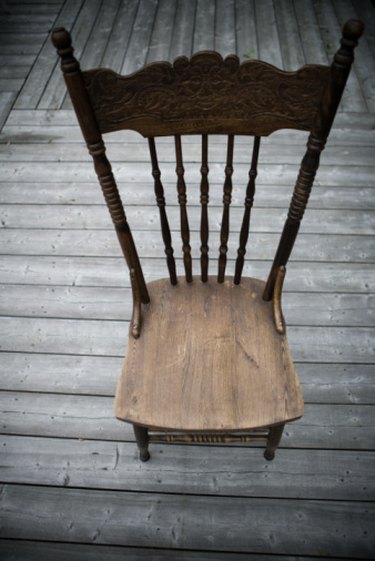Things You'll Need
280-grit sandpaper
Sponge
Paintbrush
Tack cloth
Two-part hydrogen peroxide
Neutralizing agent
Vinegar

Pickled wood finish is actually a light-colored stain. Because stain penetrates the surface to color the wood underneath; you can't simply strip it away. To remove the coloring, you must chemically bleach the top layer of the wood. The removal process will lighten the wood slightly. However, it will remove the existing stain and render the wood a more uniform color. Once you have finished removing the pickled wood finish, you can stain the wood a darker color, paint it or learn to love its lighter color.
Step 1
Sand the surface of the wood with 280-grit sandpaper. Sand with medium pressure, in the direction of the wood grain. Stop when you have slightly roughened the entire surface of the wood.
Video of the Day
Step 2
Brush away the sanding dust with a dry paint brush. Pay extra attention to the cracks and crevices where dust can collect.
Step 3
Mix and apply a two-part hydrogen peroxide wood bleaching agent (available at many hardware stores) according to the manufacturer's instructions. Pay close attention to the label. Some manufacturer's require you to mix the parts and then apply it to the wood. Others require you to apply one part and then the other. Use a sponge to make the application to flat surfaces. Use a clean, dry paintbrush to apply the bleach to the joints, cracks and details in the wood.
Step 4
Apply the neutralizing solution to the wood. Only use the neutralizing solution recommended by the hydrogen peroxide's manufacturer. Again, use a sponge to apply it on flat surfaces and a brush to get it into the detail work.
Step 5
Apply vinegar to the wood. The vinegar will ensure that all of the bleaching agent is neutralized. Again, use a sponge to apply it on flat surfaces and a brush to get it into the detail work.
Step 6
Wipe the wood down with water to remove all traces of the vinegar. Again, use a sponge to apply it on flat surfaces and a brush to get it into the detail work.
Step 7
Allow the wood to dry for 48 hours.
Step 8
Sand the surface of the wood with 280-grit sandpaper. Sand with medium pressure in the direction of the wood grain. Stop when you have slightly roughened the entire surface of the wood.
Step 9
Brush away the sanding dust with a dry paint brush. Wipe the wood down with a tack cloth to remove any lingering dust. Crumple the tack cloth first to increase the surface area and it will clean more effectively.
Tip
Apply all liquid sparingly. Puddled liquid can saturate the wood and cause it to swell and warp. Squeeze out your sponge or brush until it stops dripping before using it on the wood.
Video of the Day